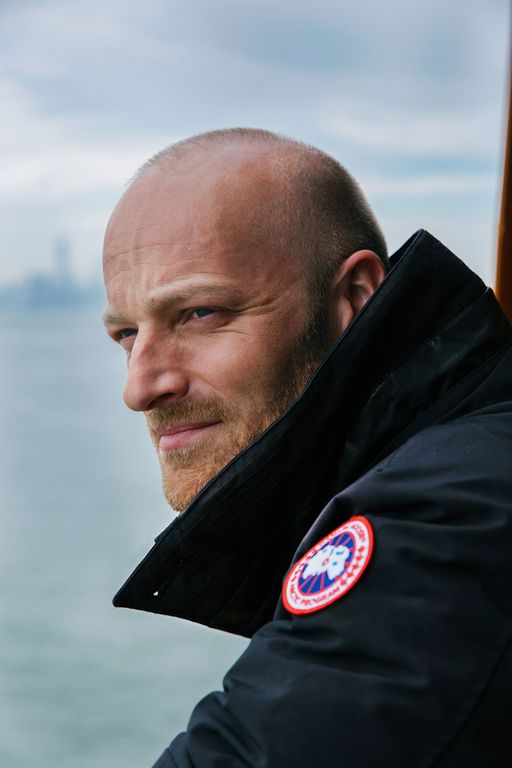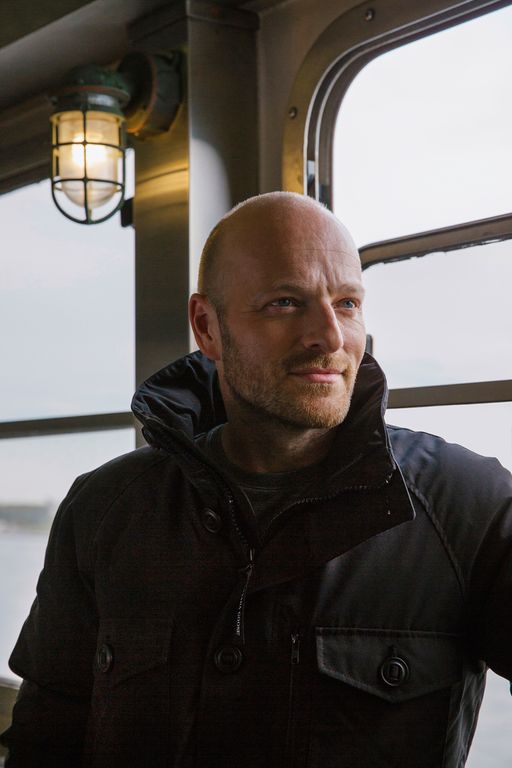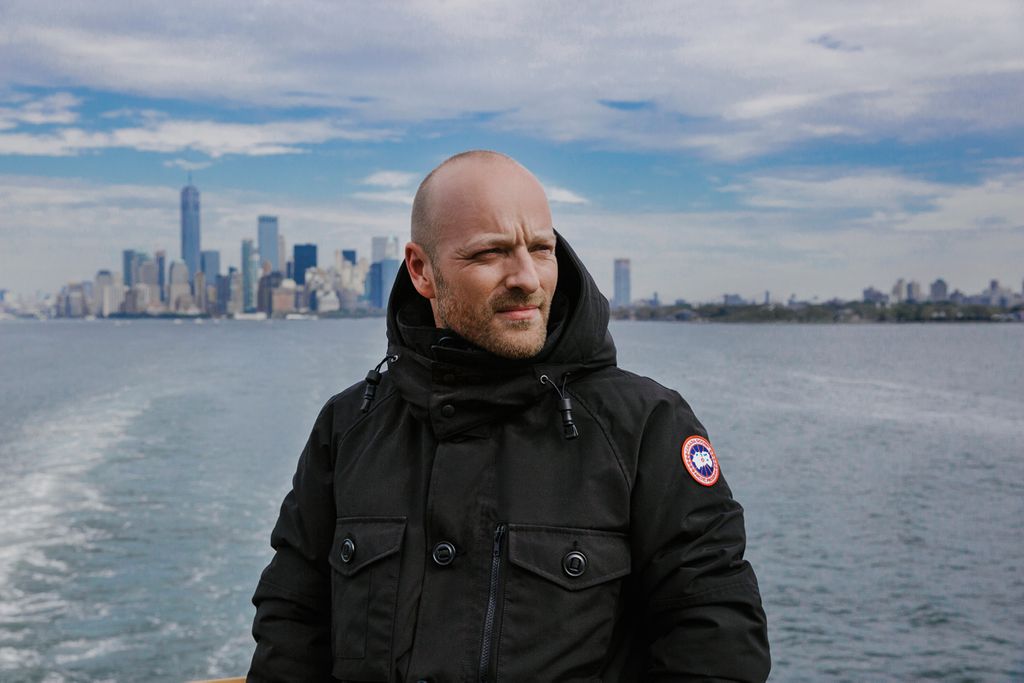
Ben Saunders is in the business of the extreme. A polar explorer by trade, he’s logged nearly a dozen excursions over the last two decades, tallying up to over a year spent in sub-zero temperatures and nearly 4,000 miles trekked across frozen landscapes.
Although Saunders has accomplished a lot over the years (like in 2004 when he became the youngest person to ski solo to the North Pole), perhaps most impressive is the Scott Expedition. Between October 2013 and February 2014, Saunders and partner Tarka L’Herpiniere completed this 1,795 mile, 108-day cross-Antarctica journey on foot. Following the course of Captain Robert Falcon Scott’s ill-fated 1911-1912 expedition (the entire crew perished attempting the treacherous route), the pair set out from the coast, eventually arriving at the South Pole to turn right around for the return journey. Although they had to call for a resupply on day 70, a decision that Saunders counts among his most difficult ever, this marked the longest human-powered polar journey in history.
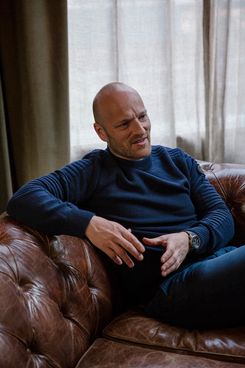
Now, Saunders is gearing up for what could be his most ambitious excursion yet. In partnership with Canada Goose, over the next two months he’ll be attempting the first solo and unsupported crossing of Antarctica. During this journey, Saunders will face temperatures that could dip to -60 degrees – he’ll be outfitted in a Canada Goose shell, parka, vest, and pants to combat the chill. On top of it all, he’ll be lugging his own supplies – about 300 pounds worth at the get-go – via sled. It’s a beyond-daunting task, but it’s a particularly important one to Saunders. He’ll be making the trek to honor a friend’s memory. Fellow explorer and British army officer Lt. Col. Henry Worsley nearly completed the journey in 2016, but fell ill some 30 miles short of the finish line.
Just weeks before he was slated to depart, we caught up with Saunders in New York to learn more about how he’s embraced the cold over the years, and how, in turn, it’s shaped who he’s become. In the spirit of adventure, we played urban explorer for the day, riding the Staten Island Ferry and traversing lower Manhattan before settling in for our interview at the Soho Grand Hotel.
When did you first realize that exploration was your calling?
Ben Saunders: I grew up in the Southwest UK; it’s a very rural area. I was outdoors a lot as a kid, so I always loved being outside, loved adventure, loved the physical challenge, and just testing my ability. I think the seeds were there for a long time.
I also blame it on a guy called John Ridgway, who, along with another guy called Chay Blyth, were the first duo to row across the Atlantic. They crossed from Massachusetts to Ireland in a wooden boat in 1966. As a teenager, Ridgway was a bit like my superhero. I ended up working for him for a year when I was 18 or 19 as an instructor. He ran what he called an “adventure school” – he was such an inspiring role model to be around, and a fantastic mentor. He got me thinking very differently about my aspirations. I had this fascination with people that were pushing the limits, and that was something I deeply aspired to be.
What drew you to frozen landscapes specifically?
I’ve joked that it’s because I wanted to be an astronaut as a kid and this is the closest I’m gonna get. This is a relatively low-budget way of getting the same sort of experience. Antarctica in the early spring is -25 C, -15 C and you’re in an environment that might as well be a different planet. Without any clothes on, you’d be dead in a couple of minutes. There’s something quite special about being able to survive in those conditions. The clothes you’re wearing and the equipment that you’re dragging behind you becomes almost like a life-support system. To me, that’s part of what makes it so compelling.
Speaking of extreme environments, in 2014 you successfully completed the Scott Expedition, crossing Antarctica on foot. What it was like taking those very first steps?
In some ways, everything was toughest at the start. We started very early in the season – everything’s the other way around, so spring is basically October. So, we’re in mid-October and it was very, very cold and our loads were at their heaviest. The two of us were wearing harnesses pulling 400-pound sledges with everything we thought we would need for three-and-a-half months. Everything is really hard on day one, day two, day three – you’re kind of in shock because just nights ago you were in a hotel and things were great. You could order room service, and suddenly you’re in a tent in -45 degrees.
I think it was day two, and we were climbing away from the coastline on this fairly gradual incline, but we were just traveling so slowly with these heavy, heavy sledges. I was measuring my pace by looking at the distance that one ski binding would slide past the other. You’re thinking, “Hey, I’ve got 1,800 miles to go here, and I’m working this hard for a few inches.” It just seemed absurd.
So early on, the ultimate goal seemed so massive that it felt not only impossible, but just totally abstract. You have to trust that things will improve, the sledge will get lighter, and the scenes will change, and it’ll get warmer.
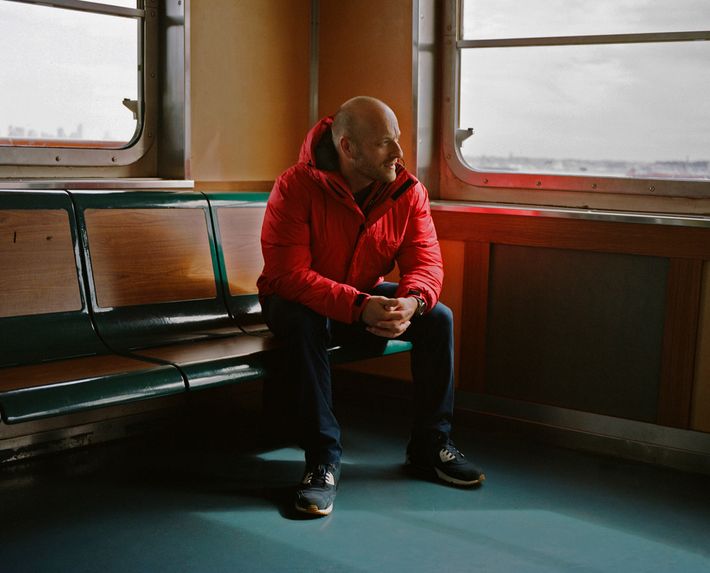
What strategies did you use to stay motivated?
In terms of staying motivated, there were two of us and we were great friends. There was a lot of mutual respect and trust. I think part of the reason was not wanting to let each other down. Then, I think most importantly for both of us was the ability to reframe the situation to the point where it became manageable. Sometimes that was just thinking a day or maybe even a few hours ahead, and almost kind of giving myself permission to quit was helpful. I’d say, “Okay, we can quit today, because things seem hopeless. But we’re not gonna quit right now, we’re gonna ski to that bit of ice on the rising because that looks like a good campsite.” Invariably, we’d get there, and we’d think, “Well, that wasn’t too bad. Let’s do another hour.” So we often had to break it down into little chunks that could be manageable.
What would you say was the absolute most challenging moment for you?
We had a period where we ran very low on food, and for several days we halved the rations. That was miserable. I think we did five or six days on half-rations, so we were hungry and becoming progressively weaker and more tired. And just knowing that was having an effect on our decision-making capacity, and feeling everything slowing down … that was really scary. We were definitely on the edge at that point.
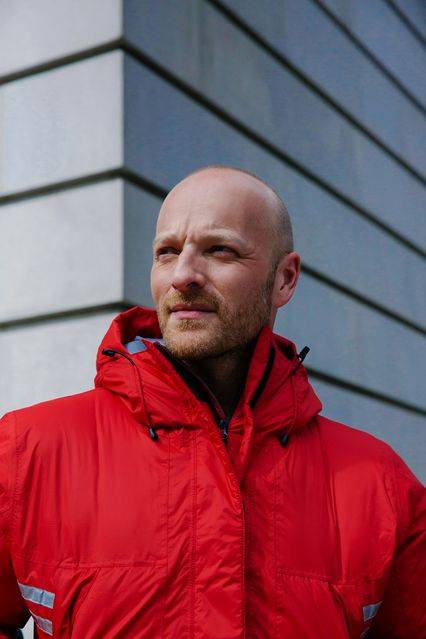
On the flip side, what would you say was your highest point?
It’s not the obvious: It’s not the South Pole. That was strangely devoid of emotion – we just turned around at the pole and started walking away again. That was always our halfway point, so it wasn’t really a climactic moment. Neither was finishing, in a strange way. We were so exhausted by then that it just didn’t really register. All we wanted to do was stop, and sleep, and eat, and just recover.
There were a few amazingly high points though. One of them was on the way to the South Pole. There’s a big mountain range called the Transantarctic Mountains, and we got there after about a month. We climbed up this giant glacier called Beardmore Glacier, where there’s a feature called “the Gateway” – the Gateway and the Beardmore were both discovered and named by Sir Shackleton. So here’s this landmark that was discovered by a legendary character, and we had beautiful weather – blue skies, the sun was shining – and I just remember thinking, “How many people have seen this firsthand?” Very few. It’s a pretty cool group to be a part of, the people who have seen that firsthand: Shackleton’s team, Captain Scott’s team … that was a very special moment.
As a polar explorer, you’re forced to make a lot of difficult decisions and weigh risks. Tell us about a particularly tough call.
Having to call for more food and supplies on the last expedition felt at the time like it was defeat. My dream had been to make that journey with no outside support. It felt like a compromise, but now, three years off, it’s one of my proudest decisions. The alternatives don’t really add up … we could’ve quit, of course. Or we could’ve carried on in some really dangerous conditions with absolutely no safety margin.
At the time it was such a tough call, and it was literally a call – we had to pick up the satellite phone and start speaking to logistics specialists. It was sort of me coming face to face very directly with this drive for perfection. Looking back, I think that was the moment I matured as a leader and learned to really prioritize properly – to make sure that my own health, and welfare, and safety, and that of my teammates, ultimately came first. Getting home was the most important thing, and anything beyond that is a bonus.
What’s your mindset going into this next excursion?
I just don’t really have much time to stop and question what’s actually happening or reflect. This is done with every expedition; it becomes so busy beforehand that you nervously get swept along with the momentum of it all. I remember spending most of the summer thinking, “Oh, it’s ages away.” And now suddenly it’s a couple weeks away. Having said that, I’m certain that I’m better prepared than ever. I’m going down there with more confidence, wisdom, and experience than I’ve ever had.
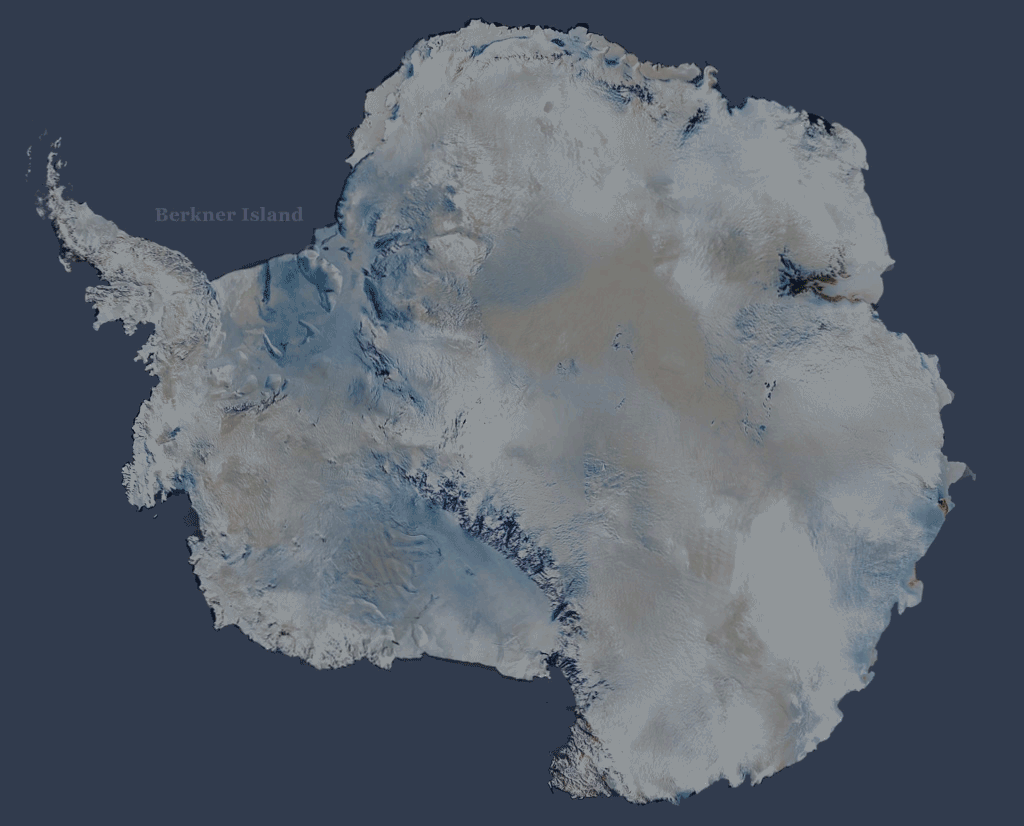
What are you most looking forward to? You’ve mentioned there’s a moment of clarity early on?
It’s almost like flipping a switch. You go from peak chaos: so many emails to answer, so many calls, and everything to organize and pack and prepare, and the training. Everything kind of reaches a peak, and then you get on the airplane, fly to Antarctica, get dropped off several days later, and you’re literally disconnected. You’ve just gotta be ready.
And life sometimes becomes very simple. It’s just about walking, and looking after myself, staying warm, eating, drinking. The scenery doesn’t change much. I’m wearing the same clothes every day, living in a tent. I always really enjoy that. It’s always quite a shock, but there’s something really special about being genuinely unplugged and disconnected like that.
What do you hope people take away from your adventures?
I guess it’s twofold. One: to engage people with a place that they’re not likely to visit in their lifetime. If Antarctica starts melting, there will be this profound change that’s felt all around the world. It’s an area that few of us get to see and that very few people understand. People are amazed when I say how big it is: it’s the size of China and India put together. I think I’m engaging people with a place that is a long way out of sight, and therefore out of mind for most.
The second thing is that it’s a story about a big goal, and about a challenge, and about trying hard, and working hard, and perseverance, and dedication. Nowadays, I think there’s this myth of overnight success and overnight celebrity, a sort of talent contest where winner takes all and life changes in a split-second. For me, this is a story about a career-long obsession, and a lot of very hard work and dedication along the way. It’s a story about getting stuff done, really. I hope it might get people thinking slightly differently about their own aspirations, their own goals, their own challenges, and how they’re spending their time.
In a Ted Talk, you mentioned that the average American spends nearly 90 percent of their time indoors. Is another goal to simply inspire people to get outside?
Definitely. Most of us are now surrounded by this incredibly addictive technology. I’m as guilty as anyone getting glued to my phone, and checking Instagram, and then switching to my email, checking the headlines, checking my bank balance, going back to Instagram. You get stuck in this endless loop of just scrolling and pulling down the screen waiting for the next little thing. There’s more stimulus than ever before, and this technology is designed to be addictive and to consume our attention.
I think part of this message is very simply about the importance of just kind of getting outside, and experiencing nature again. We’ve all got these physical bodies that are designed to do physical work, and to most people a productive day is sending 50 emails. It’s about influencing adventure in the broader sense of the word – just getting outdoors, experiencing new things.
If you had to boil it down to one key thing, how would you say your expeditions have shaped you as a person?
That is a tough question. One thing I talk about a lot is self-belief, and looking back, that’s been one of the biggest ingredients of getting to where I have. I don’t for a second mean that in an egotistical kind of “check me out” way, but rather, facing one’s own capacity to change things. It’s about believing that things tomorrow can be better than today, and that I’ve got the capacity to make that happen somehow. In my experience, self-belief is a malleable human quality, a bit like a muscle. The more you challenge it, the more you test it, the more you stretch it, the stronger it becomes. It’s been a lesson in the importance of dedication and perseverance, and focus and sheer stubbornness – the ability to keep going and refusing to give in. It’s been a big lesson in the power of self-belief.
Follow Ben’s expedition every Wednesday @canadagoose.
Photography by Anna Ottum; Grooming by Sae-Ryun Song for Defacto
This is paid content produced for an advertiser by New York Brand Studio. The editorial staff of Daily Intelligencer did not play a role in its creation.

